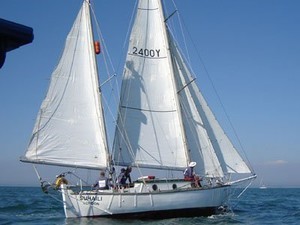Sir Robin's Suhaili to the Beautician
by MBLA/Sail-World on 30 Apr 2008

Suhaili with full rig SW
The Suhaili is going to the beautician. Yes, the valiant little 10 metre Indian built ketch, the first sailing boat to circle the globe non-stop, and sailed to victory by Robin Knox-Johnston in the 1968 Golden Globe race, is to have a major refit.
During the 1968 Golden Globe Race, which he won as the only starter to finish, he observed: 'I am beginning to wonder how much of the original boat I am going to be left with by the time I reach home. So far I have written off the self-steering gear, two tillers, a jib, a spinnaker, half the cooking stove, and the water tank. The cabin has shifted and leaks, and its canvas cover is cracking up.'
Following that transmission, he was not heard of for another 134 days - which, in these days of satellite phones and sailmail, is enough to boggle the mind of the modern long ranger sailor.
Here's the full story, worth remembering next time you go cruising:
Merchant marine officer Robin Knox-Johnson was stationed in India with the British Steam Navigation Company when he built the teak-hulled ketch Suhaili. (The name is Arabic for the southeast wind.)
Ordered home for work on the run between England and Africa, he sailed Suhaili the 12,000 miles back to London with his brother and a friend. A year later, motivated in part by rumors that the French yachtsman Eric Tabarly was planning a nonstop, solo circumnavigation—and determined that an English sailor should be the first—Knox-Johnson began preparing for the same.
In the meantime, the Sunday Times put up the Golden Globe award for the first person to accomplish this feat. Between June 1 and October 31, 1969, six boats set sail: John Ridgway's English Rose, Chay Blyth's Dytiscus, Suhaili, the French Bernard Moitessier's Joshua, and two English trimarans, Donald Crowhurst's Teignmouth Electron and Nigel Tetley's Victress.
Suhaili sailed third, departing Falmouth on June 14, 1968. Over the course of the next 310 days, she would log an average of 96.2 miles per day, following what Sir Francis Chichester had called the clipper route on his one-stop circumnavigation in Gipsy Moth IV. Suhaili did not have an easy time of it. A knockdown off the Cape of Good Hope rendered her radio inoperable for most of the rest of the voyage.
Crossing the Indian Ocean, Knox-Johnson decided to sail through Bass Strait rather than south of Tasmania, and there Suhaili took another knockdown that resulted in damage to the water tanks, tiller, and self-steering gear. Pressing on, he crossed the Tasman Sea and sailed through Foveaux Strait between New Zealand's South Island and Stewart Island, only to run aground on a sandbar near Dunedin. (The challenge judges determined that this did not constitute a stop.) Shortly after this he radioed his sponsors, the Sunday Mirror and True magazine:
I am beginning to wonder how much of the original boat I am going to be left with by the time I reach home. So far I have written off the self-steering gear, two tillers, a jib, a spinnaker, half the cooking stove, and the water tank. The cabin has shifted and leaks, and its canvas cover is cracking up.
This upbeat transmission was his last for 134 days, during which Suhaili ran her easting down in the Roaring Forties, rounded Cape Horn on January 17, 1969, and sailed up the Atlantic. There was no word of Suhaili until April 5, when a British tanker spoke her about 500 miles west of the Azores. Thirteen days later she was off the coast of England, but four days of adverse gales kept Knox-Johnson from making port until April 22, when he landed at Falmouth, having sailed 30,123 miles in 313 days.
While his achievement garnered Knox-Johnson the Golden Globe, his fellow sailors seemed poised to complete the circuit in faster time. As it happened, none finished. Blyth was forced to land in South Africa. Having averaged 110.6 miles per day, Tetley's Victress broke up after 247 days at sea, 1,200 miles from Plymouth. After rounding Cape Horn, Moitessier thought better of racing and decided to stay in the Roaring Forties before turning north for Tahiti, sailing 37,455 miles in 301 days without touching land. Most curious of all was the fate of Donald Crowhurst, whose Teignmouth Electron was found drifting in the Atlantic on July 10, only days after he had slipped over the side.
Suhaili was repaired and Knox-Johnson resumed long-distance voyaging in her. In 1989, he crossed the Atlantic using only fifteenth-century navigational techniques and instruments. Two years later, Suhaili made her first voyage north of the Arctic Circle, when Knox-Johnson took a group of four climbers and photographers to attempt Cathedral Mountain, 30 miles inland from Greenland's Kangerdlugssuaq Fjord (68°12N, 31°50W).
He was knighted in 1995 and, at the age of 68, completed his second solo circumnavigation of the world in the yacht SAGA Insurance in 2007, finishing in 4th place in the Velux 5 Oceans race
He was the oldest competitor in the race, and richly deserves his hero status in the world sailing community.
If you want to link to this article then please use this URL: www.sail-world.com/43987